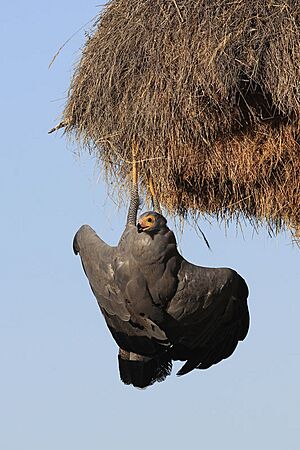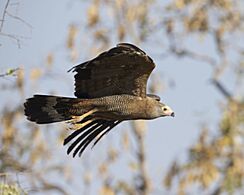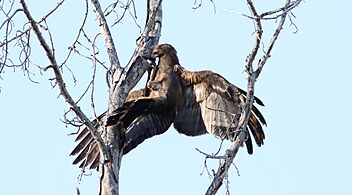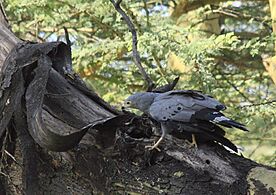African harrier-hawk facts for kids
Quick facts for kids African harrier-hawk |
|
|---|---|
 |
|
 |
|
| Adult, settled on sand bank and in flight | |
| Conservation status | |
| Scientific classification | |
| Genus: |
Polyboroides
|
| Species: |
typus
|
| Subspecies | |
|
|
The African harrier-hawk, also known as the harrier hawk or gymnogene, is a type of bird of prey. Its scientific name is Polyboroides typus. This bird is about 60–66 centimeters (24–26 inches) long. It lives and breeds in most parts of Africa south of the Sahara desert. The only other bird in its group (genus) is the Madagascar harrier-hawk, which lives only in Madagascar.
Contents
What Does the African Harrier-Hawk Look Like?

The African harrier-hawk is a medium-sized raptor, which means it's a bird that hunts other animals. Its upper body, head, and chest are light grey. Its belly is white with thin, dark stripes. The wide wings are light grey with a black edge and a thin white line. Its tail is black with one wide white band.
Around its eyes, it has a bare patch of skin that can be red or yellow. Male and female harrier-hawks look similar. Young birds, however, are pale brown instead of grey. Their black parts are dark brown.
One special thing about this bird is its unique ankles. They are "double-jointed." This allows the bird to bend its legs in unusual ways. It can reach deep into holes and cracks to find hidden prey. Another bird, the crane hawk from the Americas, has a similar leg structure. This is an example of convergent evolution, where different species develop similar traits.
The African harrier-hawk makes a whistling sound. It sounds like sueee-sueee-sueee.
Where Do African Harrier-Hawks Live?
African harrier-hawks are common raptors south of the Sahara desert. They are most often found in the warm, wet areas of western Africa. They are less common in East and South Africa.
These birds can live in many different places. For example, in the Dzanga-Sangha Special Reserve in the Central African Republic, they live in thick rainforests. They also live at the edge of forests, near rivers, on farms, and even in places where people live.
African harrier-hawks can adapt well to both city and country areas. They are one of the most common raptors in traditional villages in eastern Guinea-Bissau. They have even been known to build nests in palm trees found in cities and city gardens.
How Do African Harrier-Hawks Live?
Breeding and Nests
When Do They Breed?
The breeding season for African harrier-hawks changes depending on where they live. In Nigeria, they breed from March to August. South of the equator, they usually breed in the summer months. For example, in South Africa, it's November to December. In Zambia, Malawi, and Zimbabwe, it's September to November.
Building Their Nests
African harrier-hawks usually build their nests in large trees. Sometimes these trees grow out of or are on rocky cliffs. Their nests are round and often placed in the main fork of a tree. They are usually below the top of the tree's leaves (the canopy).
These birds can use the same nest for several breeding seasons. Their nests are quite large, like those of other raptors. They can be about 0.75 meters (2.5 feet) wide and 0.2 meters (0.7 feet) deep. They build their nests from sticks and line them with leaves from nearby trees. A female harrier-hawk usually lays one to three eggs.
Courtship Dances
When African harrier-hawks want to find a mate, they perform a special courtship display. Both birds in a pair will fly slowly and high up in the sky. You can often hear them calling during this time.
When the male flies alone, he often flies in a wavy pattern and flaps his wings. When the pair flies together, the male has been seen diving towards the female. He might touch her back with his talons. The female might even turn over and touch talons with the male.
What Do African Harrier-Hawks Eat?
The African harrier-hawk eats many different things. It is omnivorous, meaning it eats both plants and animals. It eats the fruit of the oil palm tree. It also hunts small animals with backbones (vertebrates).
Because of its special legs, it can climb using both its wings and feet. This helps it raid the nests of birds that nest in holes, like barbets and woodhoopoes. It steals their eggs and baby birds. It has also been known to hunt animals that are not native to Africa. These include feral pigeons, house sparrows, and eastern gray squirrels.
How Do African Harrier-Hawks Hunt?
African harrier-hawks use four main ways to hunt:
- Low soaring: This is the most common method. The harrier-hawk flies close to the top of the trees (the canopy). Smaller passerine birds often chase and bother it (this is called mobbing). The harrier-hawk uses how aggressive these small birds are to find their nests. If the mobbing becomes less aggressive, the harrier-hawk knows it's found the area where the small birds are most upset. It will then start looking for nests in those trees.
- High soaring: To catch reptiles in open areas, African harrier-hawks fly very high, up to 100 meters (330 feet). They then quickly dive down to just above the plants where their prey was.
- Perch hunting: They often use this method to hunt invertebrates like grasshoppers and other insects. They sit on a branch and wait for prey.
- Canopy and ground foraging: Here, the harrier-hawk either walks on the ground or moves between branches in the trees. It looks for prey in cracks and holes in both trees and on the ground.
Gallery
-
Adult soaring alongside a martial eagle (Polemaetus bellicosus), Zimbabwe








